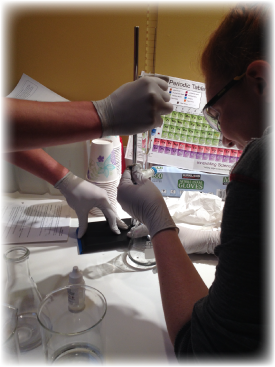|
THE GREEN BLEND: SCIENCE
Honors Chemistry with Lab
 The twentieth century saw breakthroughs in chemistry that we now take for granted: The twentieth century saw breakthroughs in chemistry that we now take for granted:
- the discovery of sub-atomic particles — the electron, neutron, and proton;
- the discovery of sub-sub-atomic particles like quarks, leptons, and bosons;
- nuclear fission and nuclear fusion;
- the invention of plastics, nylon, and other man-made polymers;
- methods to increase efficiencies of organic compounds in fuel.
 These breakthroughs have enabled humanity to live better and longer. Is there any doubt that far-reaching and exciting breakthroughs will be realized this century? These breakthroughs have enabled humanity to live better and longer. Is there any doubt that far-reaching and exciting breakthroughs will be realized this century?
In this class each student acquires both a deep understanding of chemistry and an appreciation for its real-world applications. The class is divided into one or two lectures each week and a lab session approximately every other week. Each lecture begins with broad concepts foundational to a topic and then delves into that topic in greater detail. Lectures feature video, graphics, and PowerPoint presentations. Students are provided with printed materials, graphics, labs, and worksheets to be completed at home.
 Among the topics covered in this course: Among the topics covered in this course:
- the scientific method;
- significant digits;
- properties of matter;
- atomic theory;
- the periodic table of elements;
- Lewis Dot Diagrams;
- bonding—covalent & ionic, polarity;
- properties of water;
- compounds;
- solutions;
- separating mixtures;
- distillation;
- stoichiometry;
- limited reactants and percent yield;
- the mole;
- mole conversions;
- molecular geometry;
Texts & other items to purchase
Here are the items needed for Honors Chemistry with Lab — The first three links below are to the correct editions on Amazon; the link to a calculator is for a model suitable for this class.
Your student will also need a notebook or binder with loose leaf paper (for taking notes in class) and a section for various handouts.
Additional reading:
- The Disappearing Spoon by Sam Kean
ISBN-10: 0316051632 | ISBN-13: 978-0316051637
- Periodic Tales by Hugh Aldersey-Williams
ISBN-10: 0061824739 | ISBN-13: 978-0061824739
- Stuff Matters by Mark Miodownik
ISBN-10: 0544483944 | ISBN-13: 978-0544483941
- thermo-chemistry and chemical kinetics (energy absorption, reaction rates);
- chemical equilibrium pH, acids, bases and salts (buffers);
- redox reactions;
- ions;
- gas laws (Boyle's Ideal Gas Law, Charles' Law).
This honors-level class moves at quite a clip. Students will be expected to complete four to five hours of work at home each week. Homework will consist of reading, annotating text, watching videos, completing worksheets, doing independent research, writing lab reports, and studying.
Class activities:
- Periodic in-class quizzes will be administered in the form of solo and small-group activities and games. The objective of these quizzes will be learning and mastering the content, not generating a grade.
- Between classes, students will interact with the teacher and other students via the Internet, asking and answering questions.
- Students will be assigned topics to research independently. All students are required to present both in class and online.
- Six tests will be provided to parents to administer at home as they wish: open book, closed book, as a learning tool, as a grade generator, or any combination.
Among our labs are the following:
- Safety in the Lab;
- Measurement;
- Density vs. Weight;
- Electron-shells modeling;
- Quantum numbers & electron orbitals;
- Electron configurations;
- Periodic law;
- Finding the missing element (Periodic table);
- Designing your own periodic table;
- Differential solubility;
- Nomenclature: Compounds;
- Solubility: Solvent/Solute Interaction;
|
- Simulation: Molecular Polarity;
- Simulation: Molecular Geometry;
- Preparing solutions & reagents;
- Examining Oxidation States;
- Determining the Formula of a Hydrate;
- Observing a single-displacement reaction;
- Stoichiometry of a double-displacement reaction;
- Observing the Volume-Pressure Relationship of Gases;
- Observing the Volume-Temperature Relationship of Gases;
- Acids & bases – dilutions & titration.
|
Prerequisites
It is recommended that students complete Algebra I before taking this class.
|
|
|
Our approach to ...
Science
Sciences at The Blend aim high. At the same time, we provide in-depth studies of the discipline for two kinds of students:
- those new to the formal study of science;
- those who have already studied science deeply for years.
Our courses employ college texts, websites from universities, AP-level labs, and in-depth explorations. All content is taught by subject-matter experts who are passionate about their disciplines. In order to ensure learning and mastery of concepts, moreover, the content is taught in a tiered fashion — laying foundational concepts, building up and delving deep into the facts, and reinforcing by looping back to essential concepts covered earlier in the course.
These methods ensure that no student is left behind. Rather, students come away with a full picture of the science and the interconnectedness of topics. Students with more science acumen can learn deeply while students new to the discipline learn comprehensively.
|
|
![]()